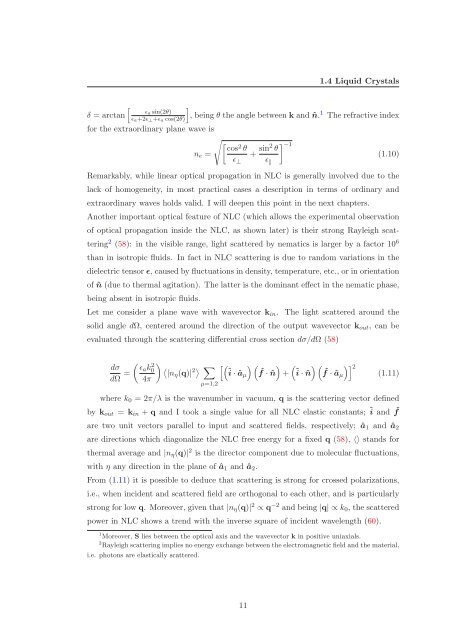Solitons in Nonlocal Media
Solitons in Nonlocal Media
Solitons in Nonlocal Media
Create successful ePaper yourself
Turn your PDF publications into a flip-book with our unique Google optimized e-Paper software.
δ = arctan<br />
ǫa s<strong>in</strong>(2θ)<br />
ǫa+2ǫ⊥+ǫa cos(2θ)<br />
for the extraord<strong>in</strong>ary plane wave is<br />
<br />
cos<br />
2 θ<br />
ne =<br />
1.4 Liquid Crystals<br />
<br />
, be<strong>in</strong>g θ the angle between k and ˆn. 1 The refractive <strong>in</strong>dex<br />
ǫ⊥<br />
+ s<strong>in</strong>2 −1<br />
θ<br />
ǫ (1.10)<br />
Remarkably, while l<strong>in</strong>ear optical propagation <strong>in</strong> NLC is generally <strong>in</strong>volved due to the<br />
lack of homogeneity, <strong>in</strong> most practical cases a description <strong>in</strong> terms of ord<strong>in</strong>ary and<br />
extraord<strong>in</strong>ary waves holds valid. I will deepen this po<strong>in</strong>t <strong>in</strong> the next chapters.<br />
Another important optical feature of NLC (which allows the experimental observation<br />
of optical propagation <strong>in</strong>side the NLC, as shown later) is their strong Rayleigh scat-<br />
ter<strong>in</strong>g 2 (58): <strong>in</strong> the visible range, light scattered by nematics is larger by a factor 10 6<br />
than <strong>in</strong> isotropic fluids. In fact <strong>in</strong> NLC scatter<strong>in</strong>g is due to random variations <strong>in</strong> the<br />
dielectric tensor ǫ, caused by fluctuations <strong>in</strong> density, temperature, etc., or <strong>in</strong> orientation<br />
of ˆn (due to thermal agitation). The latter is the dom<strong>in</strong>ant effect <strong>in</strong> the nematic phase,<br />
be<strong>in</strong>g absent <strong>in</strong> isotropic fluids.<br />
Let me consider a plane wave with wavevector k<strong>in</strong>. The light scattered around the<br />
solid angle dΩ, centered around the direction of the output wavevector kout, can be<br />
evaluated through the scatter<strong>in</strong>g differential cross section dσ/dΩ (58)<br />
dσ<br />
dΩ =<br />
<br />
ǫak2 <br />
|nη(q)|<br />
0<br />
4π<br />
2 2 î · âµ<br />
ˆf · ˆn + î · ˆn ˆf · âµ<br />
µ=1,2<br />
(1.11)<br />
where k0 = 2π/λ is the wavenumber <strong>in</strong> vacuum, q is the scatter<strong>in</strong>g vector def<strong>in</strong>ed<br />
by kout = k<strong>in</strong> + q and I took a s<strong>in</strong>gle value for all NLC elastic constants; î and ˆf<br />
are two unit vectors parallel to <strong>in</strong>put and scattered fields, respectively; â1 and â2<br />
are directions which diagonalize the NLC free energy for a fixed q (58), 〈〉 stands for<br />
thermal average and |nη(q)| 2 is the director component due to molecular fluctuations,<br />
with η any direction <strong>in</strong> the plane of â1 and â2.<br />
From (1.11) it is possible to deduce that scatter<strong>in</strong>g is strong for crossed polarizations,<br />
i.e., when <strong>in</strong>cident and scattered field are orthogonal to each other, and is particularly<br />
strong for low q. Moreover, given that |nη(q)| 2 ∝ q −2 and be<strong>in</strong>g |q| ∝ k0, the scattered<br />
power <strong>in</strong> NLC shows a trend with the <strong>in</strong>verse square of <strong>in</strong>cident wavelength (60).<br />
1 Moreover, S lies between the optical axis and the wavevector k <strong>in</strong> positive uniaxials.<br />
2 Rayleigh scatter<strong>in</strong>g implies no energy exchange between the electromagnetic field and the material,<br />
i.e. photons are elastically scattered.<br />
11
















